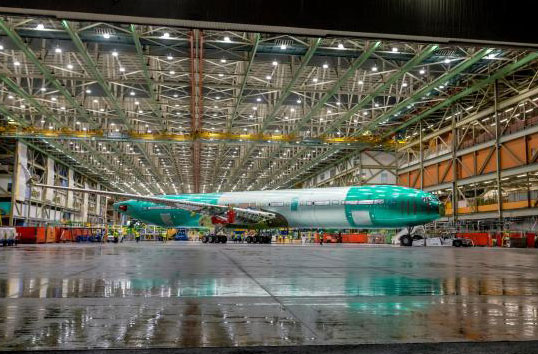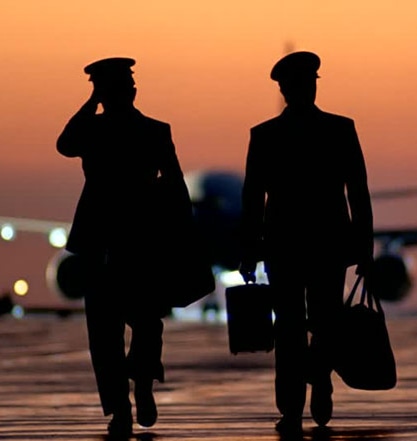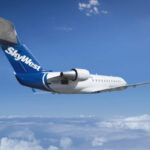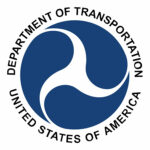Boeing Rolls Out 777x Test Airframe

Boeing has provided a first look of the world’s largest twin-engine airliner. The “fully assembled” static test plane of the 777X-9 was rolled out of the Boeing facility in Everett, Washington.
The non-flying test airplane does not have engines or avionics and will be used for nearly a year of testing to verify design strength.
“Static test is our opportunity to verify the design of the structure and load bearing components of the airplane, ensuring the final product is safe for our customers and the flying public,” says Doreen Bingo, Boeing Test and Evaluation 777X Test Program manager.
Boeing 777X Had a Warm Welcome
Boeing formally launched the new versions of its successful 777 program at the 2013 Dubai Airshow with a record breaking number of customer orders and commitments. Launch customers for the Boeing 777X included Lufthansa, Etihad Airways, Qatar Airways and Emirates with agreements for 259 airplanes.
Additional airlines have since agreed to purchase the new Boeing 777X with total orders for the airplanes standing at 326.
Firm Orders for 777X
| Initial date | Customer | -8 | -9 | Combined |
|---|---|---|---|---|
| Nov 17, 2013 | Lufthansa | 20 | 20 | |
| Nov 17, 2013 | Etihad Airways | 8 | 17 | 25 |
| Dec 20, 2013 | Cathay Pacific | 21 | 21 | |
| Jul 8, 2014 | Emirates | 35 | 115 | 150 |
| Jul 16, 2014 | Qatar Airways | 10 | 50 | 60 |
| Jul 31, 2014 | All Nippon Airways | 20 | 20 | |
| Jun 4, 2015 | Unidentified Customer(s) | 10 | 10 | |
| Jun 23, 2017 | Singapore Airlines | 20 | 20 | |
| Totals | 53 | 273 | 326 | |
Boeing 777X Design
The 777X will have a new longer composite wing with raked wingtips. The wingspan is optimized for greater efficiency and will use folding wingtips for existing gate compatibility.
Internal cabin width will be increased from 231 to 235 inches on the new 777X from the previous 777 models through thinner interior cabin walls and better insulation. The 777X will feature cabin enchancements from the 787 that include larger windows, higher ceilings, more humidity and lowered cabin altitude to 6,000 ft.
Unlike past 777s that featured as many as three engine choices the 777X will only use one engine type – the General Electric GE9X, which will develop 105,000 lbs. of thrust.
The new 777X will use five large Rockwell Collins LCD displays. These are the same basic displays used on the 787 and 737 MAX though the 777X will be the first time the displays also incorporate touchscreens.
“The overall layout is similar to the 777 and 787,” says Terry Beezhold, the 777X vice president and chief project engineer. “We have tried to keep it the same for crew training and common type rating, and we want to minimize the amount of transition training between the 777 and 787 families.”
Class two electronic flight bags (EFB) will be part of the avionics and the flight deck will have an option for dual head-up-displays (HUD).
777-8
The 777-8 is a 229 ft long shortened derivative of the 777-9. It will seat 365 passengers in a typical layout with a range of 8,690 nm.
777-9
The 777-9 is 251 ft 9 in long and is a lengthened derivative of the existing 777-300ER. It will seat 414 passengers in a typical layout with a range of 7,525 nm.
777-10X
The 777-10X is not yet in development but is a proposed stretch of the -9. The 777-10X would be 263 ft long and would seat 450 passengers in a typical layout.
| Model | 777-8 | 777-9 |
|---|---|---|
| Cockpit crew | Two | |
| Seating, 2-class | 365 | 414 |
| Length | 229ft | 251ft 9in |
| Wingspan | 235ft 5in | |
| Wing area | 5,025 sq ft | |
| Tail height | 64ft | 64ft 7in |
| Maximum takeoff weight | 775,000 lbs | |
| Range | 8,690 nm | 7,525 nm |
| Engine (×2) | General Electric GE9X-105B1A | |
| Thrust (×2) | 105,000 lbs | |
Boeing 777 Pilot Jobs
The Boeing 777 is operated by the largest airlines in the world. A pilot wanting to fly a 777 in the United States would need to get a job with a legacy airline which includes United Airlines, Delta Air Lines, and American Airlines. Flying 777 freighters is also an option at Fedex.
777s usually fly long haul routes and have among the highest pilot pay rates. The airplane is among the most desirable to for pilots to fly due to pay and quality of life. Because of this, pilots typically need to gain seniority at an airline before they have the option of flying 777s.
Pilots wishing to fly 777s sooner in their career can find other options flying for carriers outside of the Unites States. Requirements vary considerably between countries but are often less than what they are in the United States.
Greg started his professional pilot journey in 2002 after graduating from Embry Riddle. Since that time he has accumulated over 8,000 hours working as a pilot. Greg’s professional experience includes flight instructing, animal tracking, backcountry flying, forest firefighting, passenger charter, part 135 cargo, flying for a regional airline, a national low cost airline, a legacy airline, and also working as a manager in charge of Part 135 and Part 121 training programs.



